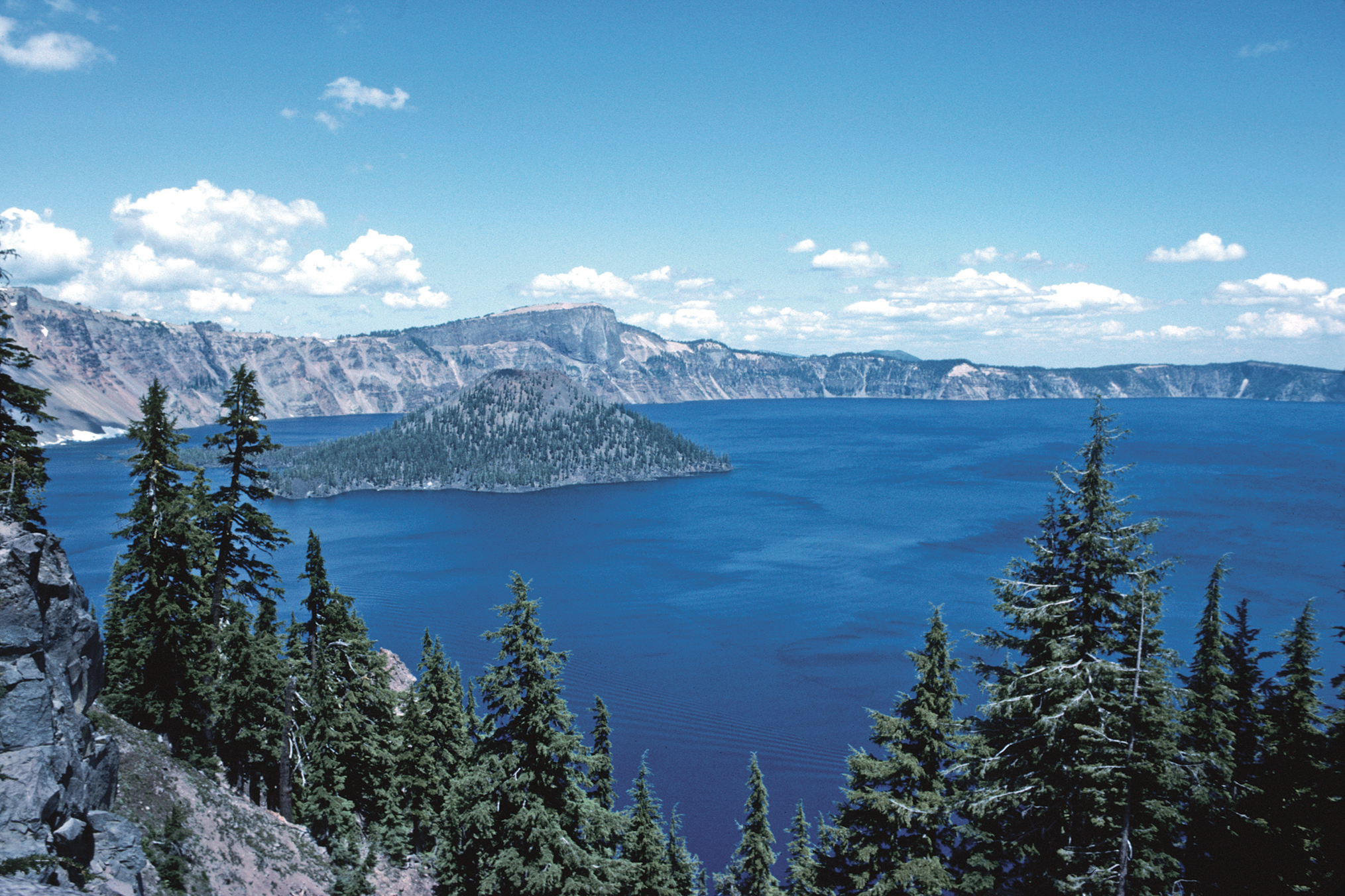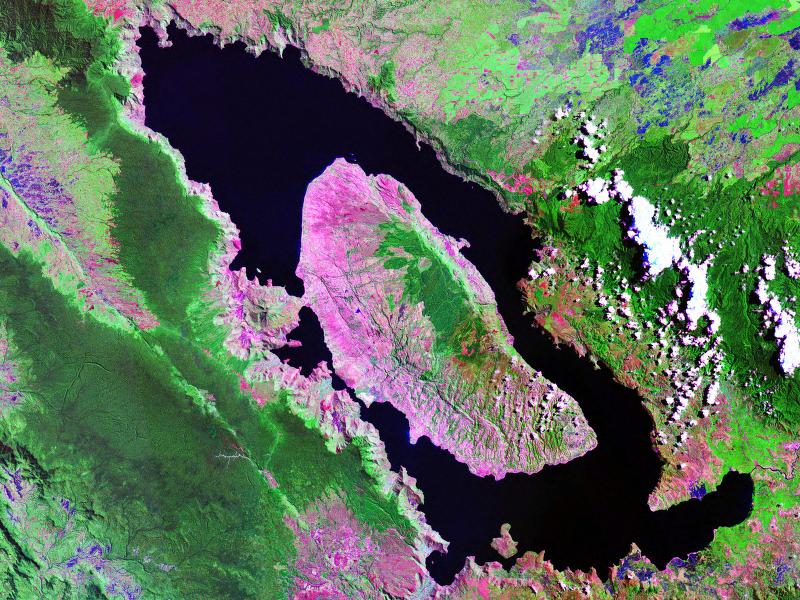Excerpted from Kiss Your Ash Goodbye: The Yellowstone Supervolcano,
© 2018
By Stephanie Osborn
Images in this article are public domain unless otherwise
noted.
What is a supervolcano?
“The term ‘supervolcano’ implies a volcanic center that has
had an eruption of magnitude 8 on the Volcanic Explosivity Index (VEI), meaning
the measured deposits for that eruption is greater than 1,000 cubic kilometers
(240 cubic miles).” ~U.S. Geological Survey
That said, often volcanic eruptions with a slightly lesser
VEI of 7 are also considered supervolcanic. This is because the VEI does not
take density of ejecta into account. Magma chemical composition varies,
depending upon the source of the melt. This can produce lava with varying
densities.
Crater Lake, in Mount Mazama, with Wizard Island
cinder cone.
What is the Volcanic Explosivity Index?
It is a means of ranking a volcanic eruption, similar to the
Richter or moment magnitude scales for earthquakes. According to the U.S.
Geological Survey, “The Volcanic Explosivity Index (VEI) is a relative measure
of the explosiveness of volcanic eruptions. It was devised by Chris Newhall of
the United States Geological Survey and Stephen Self at the University of
Hawaii in 1982.” It categorizes eruption characteristics, such as volume of
ejecta, eruption cloud height, etc. Again quoting the USGS, “The scale is
open-ended with the largest volcanic eruptions in history (super-eruptions)
given magnitude 8.” Since it is open-ended, some geologists do estimate that a
very small number of eruptions in geologic history may have reached a 9, though
such a rating is currently unofficial.
The Volcanic Explosivity Index.
Are all supervolcanoes explosive?
NO.
There are supervolcanoes known as “traps” which tend to be
nonexplosive. These are typically long cracks — sometimes fields of parallel
cracks — from which vast quantities of lava (“flood basalts”) flow over the
surrounding terrain. The term refers to the step-like terrain common to such
features. One of the best known in the geological community were the Deccan
Traps. This eruption occurred some 60 million years ago in the Deccan Plateau
region of what is now India. The residual lava beds originally may have covered
some 580,000sq.mi. (1.5million km²) —
more than 2x the size of Texas. Multiple flows over time covered the area in ~6,600ft
(2,000m) thick basalts. It is one of the largest volcanic features on Earth.
How strong is a supervolcano?
That depends on the type of supervolcano and your definition
of “strong.” There are two types of supervolcano:
1) Megacalderas, or “massive eruptions”:
These are cliff-edged craters, usually (though not always)
NOT surrounded by a mountain, where the violence of the eruption emptied the
magma chamber. The overburden collapsed into the chamber, leaving a
sinkhole-like depression.
Lake Toba — the lake IS the caldera.
2) Traps, or Large Igneous Provinces:
As already mentioned, these are huge regions of lava flow
resulting from flood basalt eruptions, often hundreds or thousands of square
miles with volumes on order of millions of cubic miles. The lavas are normally
laid down in sequential eruptions over millions of years.
Siberian Traps lava flow.
Image credit Benjamin Black via USGS.
Image credit Benjamin Black via USGS.
While traps are considered supervolcanoes, usually it is the
megacaldera which is being referenced, due to its violence.
What is the difference between traps and megacalderas?
Traps tend to be effusive and megacalderas tend to be
eruptive. This is not always true but usually is. The difference lies in the
chemistry of the melt.
Effusive flows tend to have thin, runny lava (low viscosity),
usually basaltic in composition. Dissolved gases escape quickly. This produces
dramatic lava fountains and swift flows. Example: Kilauea.
Eruptive flows tend to have thick, viscous lava (high
viscosity), usually granitic in composition. Dissolved gases are held in the
melt. Pressure builds, and an eruption
ensues when the containment (volcanic vent/neck/chamber) fails. Example: Mt.
St. Helens.
If the melt chemistry changes for any reason, a trap can
become eruptive, or a megacaldera can become effusive, at least temporarily.
How strong is a supervolcano? (Take two)
When Mt. St. Helens erupted, it released thermal energy
equivalent to approximately 24 megatons (MT). 7 MT of this was expended in the
blast alone. The St. Helens eruption was a VEI 5.
As previously mentioned, the Volcano Explosivity Index is
logarithmic. A supervolcano eruption is VEI 7-8. This is 2-3 orders of
magnitude stronger than St. Helens. A supervolcano, therefore, would release an
estimated 2,400-24,000 MT (2.4-24 gigatons (GT)) of thermal energy. If we scale
the blast size up proportionally, this would result in a blast equivalent to
approximately 700 MT to 7 GT.
How many supervolcanoes exist?
That depends on who you talk to, and what criteria they are using.
Some say as few as half a dozen, others as many as 20 or more.
Keep in mind, there may also be ocean-floor volcanos of which
we’re unaware.
A Partial List of Known Active/Dormant Supervolcanoes Currently In Existence
• Aira Caldera/Sakurajima, Kagoshima, Japan
• Baekdu Mountain, China/North Korea border
• Campi Flegri/Phlegraean Fields, Naples, Italy
• Cerro Galan Caldera, Catamarca province, Argentina
• Kurile Lake/Kurilskoye Lake, Kamchatka, Russia
• La Pacana, Zapaleri tripoint, Chile/Bolivia/Argentina
• Lake Toba, North Sumatra, Indonesia
• Long Valley Caldera, Mammoth Mountain, California, USA
(south of Mono Lake)
• Macauley Island, New Zealand
• Mount Aso, Kumamoto Prefecture, Japan
• Tambora, Sumbawa, Indonesia
• Taupo Caldera, North Island, New Zealand
• Thera/Santorini, Santorini, Greece
• Valles Caldera, Santa Fe, New Mexico, USA
• Yellowstone Caldera, Yellowstone National Park, Wyoming,
USA
To obtain a copy of Kiss
Your Ash Goodbye: The Yellowstone Supervolcano by Stephanie
Osborn, go to: http://bit.ly/Kin-KYAGTYSV.





No comments:
Post a Comment